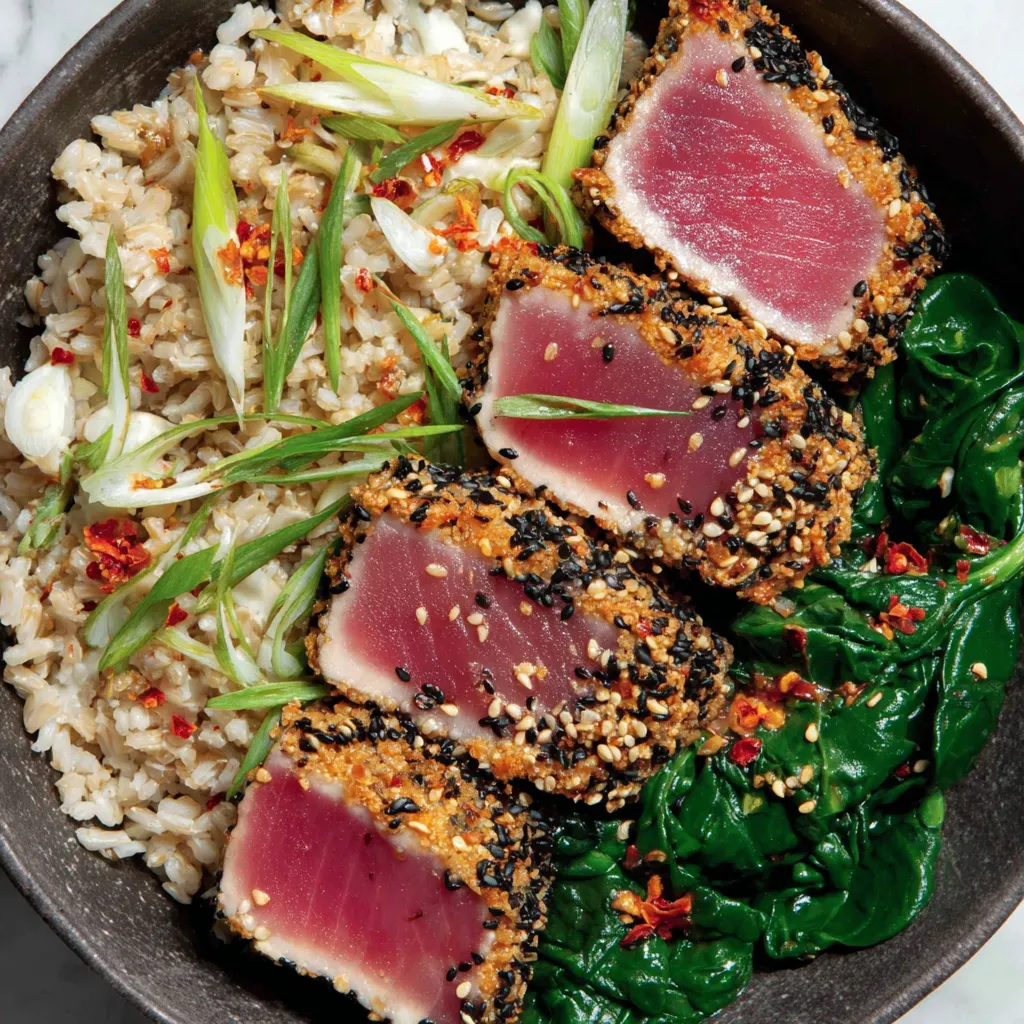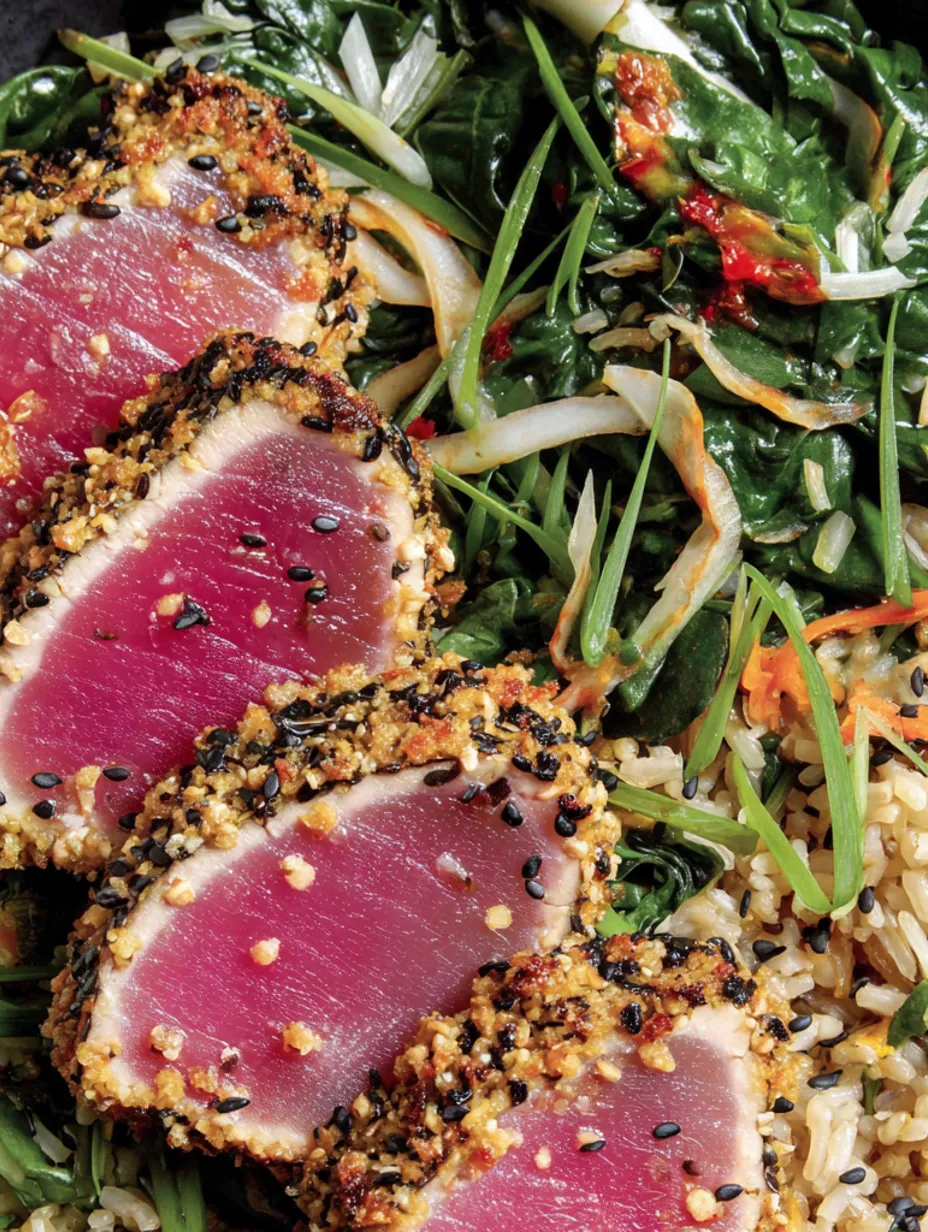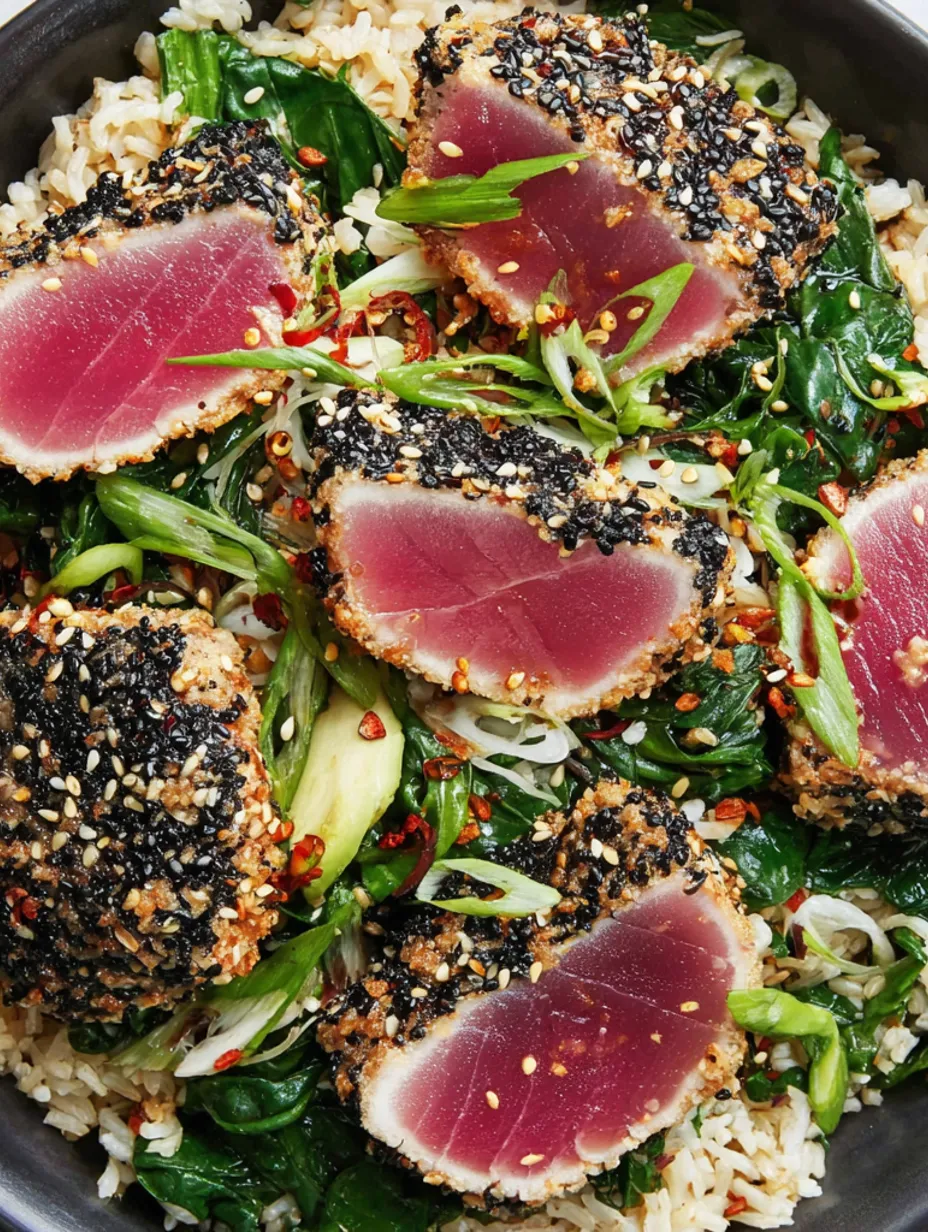 Bookmark
Bookmark
This recipe transforms weeknight dinners with sesame-crusted tuna steaks seared to a perfect rare finish paired with quick-cooking brown rice and vibrant toppings. It combines rich protein, healthy fats, and fresh vegetables in a satisfying bowl that comes together in just half an hour.
I remember making this on a busy weeknight and how quickly it became a favorite for its ease and bright flavors.
Ingredients
- Four tablespoons sesame seeds: which add a toasty crunch and nutty flavor
- Two ahi tuna fillets: weighing eight ounces each, best if sushi-grade for safety and texture
- Two tablespoons neutral oil: like canola or avocado oil for a high smoke point during searing
- Two and a half tablespoons toasted sesame oil: divided for a rich aroma and depth
- Sixteen ounces baby spinach: split to cook in stages for perfect wilt and flavor concentration
- Four tablespoons thinly sliced scallions: divided to add freshness and mild onion notes
- Two and a half teaspoons reduced-sodium tamari: divided to provide umami without overpowering saltiness
- Two teaspoons unseasoned rice vinegar: for brightness and acidity
- One teaspoon freshly grated ginger: from a half-inch piece to add warmth and zing
- Three cloves garlic grated: about one teaspoon, for pungency and depth
- One quarter cup mayonnaise: to create a creamy sauce base
- One teaspoon gochujang Korean chili paste: bringing spicy and sweet complexity
- Two packages of precooked microwaveable brown rice: each weighing 8.8 ounces for convenience
- Half teaspoon salt: divided to enhance all flavors evenly
Step-by-Step Instructions
- Sear the Tuna:
- Place the sesame seeds on a large plate and press the tuna fillets into them coating all sides. Heat the neutral oil in a large nonstick skillet over medium-high heat until shimmering. Add the tuna and cook flipping once until the sesame seeds are golden and crisp about four to six minutes for rare doneness. Transfer the tuna to a cutting board and keep the skillet ready for the next step.
- Wilt the Spinach:
- Heat one and a half teaspoons of toasted sesame oil in the same skillet over medium heat. Add half the baby spinach and stir occasionally until completely wilted, around two minutes. Add the remaining spinach and cook stirring occasionally until wilted and mostly dry, about six to eight minutes. Remove from heat and stir in three tablespoons scallions, one tablespoon toasted sesame oil, one and a half teaspoons tamari, two teaspoons rice vinegar, grated ginger, and garlic.
- Make the Sauce:
- In a small bowl combine mayonnaise, gochujang, and the remaining tamari to create a creamy spicy sauce.
- Prepare the Rice and Assemble:
- Cook the microwaveable brown rice according to package directions. Transfer to a bowl and stir in a quarter teaspoon salt and one tablespoon toasted sesame oil. Divide the rice among four bowls. Spoon about one third cup of the spinach mixture on top. Slice the tuna into quarter-inch pieces, sprinkle with the remaining salt, and arrange on the rice. Drizzle each bowl with one tablespoon of the gochujang mayonnaise sauce and sprinkle with the remaining scallions.
 Bookmark
Bookmark
I love the way the spinach absorbs all the ginger garlic and tamari flavors making each bite savory and vibrant. Preparing this for family gatherings always sparks compliments and requests for seconds.
Storage Tips
Store leftovers in airtight containers in the refrigerator for up to two days. Reheat the rice and spinach separately to avoid sogginess. The tuna is best eaten fresh but can be chilled and sliced thinly for salads or sandwiches the next day.
Ingredient Substitutions
If you prefer white rice or jasmine rice you can swap it for the brown rice for a softer texture. For those avoiding mayo you can replace the gochujang mayonnaise with a simple mix of plain yogurt and chili paste. Avocado oil can be substituted with grapeseed or vegetable oil if needed.
Serving Suggestions
Serve with a side of pickled vegetables or sliced avocado to complement the sesame and spicy flavors. Adding a soft boiled egg or fried egg on top can enhance the protein and create a more filling meal. Garnish with extra sesame seeds or furikake seasoning for an authentic touch.
Cultural Context
This bowl combines influences from Korean cuisine with gochujang and Japanese-style tuna preparation. It embraces the modern bowl trend where balanced nutrition and convenience meet. Sesame seeds have long been used in East Asian cooking for their flavor and health benefits.
 Bookmark
Bookmark
Frequently Asked Questions About Recipes
- → Can I use white rice instead of brown?
Yes, white rice can be used if preferred. It has a softer texture and cooks even faster.
- → Is ahi tuna safe to eat rare?
Yes, as long as it's high-quality, sushi-grade tuna that has been properly frozen before use.
- → What can I substitute for gochujang?
You can use sriracha or chili garlic sauce for a similar spicy kick if gochujang is unavailable.
- → Can I prepare this in advance?
You can prep components ahead, but assemble bowls fresh to maintain texture and flavor.
- → What oil works best for searing tuna?
Use a neutral oil with high smoke point like canola or avocado oil for best searing results.
